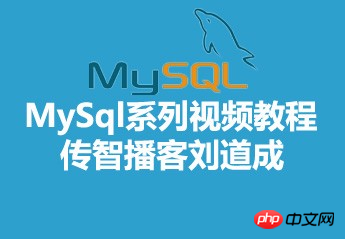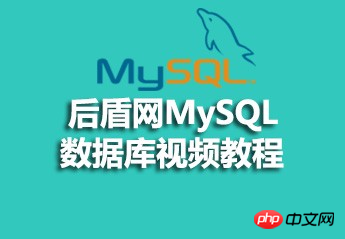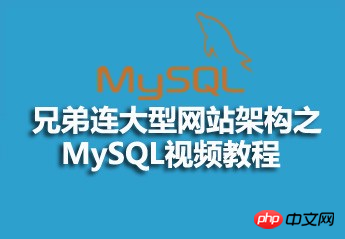 headlines
headlines
 MySQL tutorial recommendation: the 5 most recommended mysql database learning tutorials in 2021
MySQL tutorial recommendation: the 5 most recommended mysql database learning tutorials in 2021
MySQL tutorial recommendation: the 5 most recommended mysql database learning tutorials in 2021
In our daily PHP and web development, we cannot do without the database. The MySQL database that our PHP programmers use the most is a fast, free, easy-to-use RDBMS that is used in many small and medium-sized websites. , MySQL was once recognized as the best partner of PHP. We also have many mysql video tutorials on our PHP Chinese website. Today I will recommend the best MySQL videos to everyone, hoping to help everyone.
Latest course supplement:
《MySQLi Process-oriented Quick Start》
《MySQL Authoritative Development Guide ( Tutorial)》
《 Six days to take you through MySQL video tutorial》
More mysql video tutorial recommendations:《mysql tutorial》
1.《 Chuanzhi Podcast Liu Daocheng MySql series video tutorial》

2.《Background MySQL Database Video Tutorial》

3.《Power node mysql basic video tutorial》

4. "MySQL Video Tutorial on Band of Brothers Large Website Architecture"
 # #How to analyze the operation of the website from an architectural perspective, how to solve some emergencies, and how to prevent the website from crashing due to excessive traffic. If you have questions about these, then "Brothers Large Website Architecture" "MySQL Video Tutorial" is very suitable for you, let's answer these questions together! ! !
# #How to analyze the operation of the website from an architectural perspective, how to solve some emergencies, and how to prevent the website from crashing due to excessive traffic. If you have questions about these, then "Brothers Large Website Architecture" "MySQL Video Tutorial" is very suitable for you, let's answer these questions together! ! !
 The database is the storage component of most applications. It plays a crucial role in whether the programs developed by programmers can run stably and efficiently. This course starts with the basic theory of database design and combines it with simple examples to tell you simply and clearly how to design a database structure that is concise, clear, efficient and stable at the same time.
The database is the storage component of most applications. It plays a crucial role in whether the programs developed by programmers can run stably and efficiently. This course starts with the basic theory of database design and combines it with simple examples to tell you simply and clearly how to design a database structure that is concise, clear, efficient and stable at the same time.
For more MySQL tutorial video tutorials, please pay attention to: http://www.php.cn/course/list/51.html
【Related Recommendations】##1.
[mysql video tutorial] Recommended 5 most popular mysql video tutorials in 2020 Recommendations for the 4 most classic mysql database construction and management tools in 2021##3.Recommendation of the 6 best PHP environment building tools in 2021
4.php environment configuration tutorial: PHP development environment integrated installation and independent installation video tutorial

Hot AI Tools

Undresser.AI Undress
AI-powered app for creating realistic nude photos

AI Clothes Remover
Online AI tool for removing clothes from photos.

Undress AI Tool
Undress images for free

Clothoff.io
AI clothes remover

Video Face Swap
Swap faces in any video effortlessly with our completely free AI face swap tool!

Hot Article

Hot Tools

Notepad++7.3.1
Easy-to-use and free code editor

SublimeText3 Chinese version
Chinese version, very easy to use

Zend Studio 13.0.1
Powerful PHP integrated development environment

Dreamweaver CS6
Visual web development tools

SublimeText3 Mac version
God-level code editing software (SublimeText3)

Hot Topics
 1669
1669
 14
14
 1428
1428
 52
52
 1329
1329
 25
25
 1273
1273
 29
29
 1256
1256
 24
24
 MySQL and phpMyAdmin: Core Features and Functions
Apr 22, 2025 am 12:12 AM
MySQL and phpMyAdmin: Core Features and Functions
Apr 22, 2025 am 12:12 AM
MySQL and phpMyAdmin are powerful database management tools. 1) MySQL is used to create databases and tables, and to execute DML and SQL queries. 2) phpMyAdmin provides an intuitive interface for database management, table structure management, data operations and user permission management.
 Oracle's Role in the Business World
Apr 23, 2025 am 12:01 AM
Oracle's Role in the Business World
Apr 23, 2025 am 12:01 AM
Oracle is not only a database company, but also a leader in cloud computing and ERP systems. 1. Oracle provides comprehensive solutions from database to cloud services and ERP systems. 2. OracleCloud challenges AWS and Azure, providing IaaS, PaaS and SaaS services. 3. Oracle's ERP systems such as E-BusinessSuite and FusionApplications help enterprises optimize operations.
 Explain the purpose of foreign keys in MySQL.
Apr 25, 2025 am 12:17 AM
Explain the purpose of foreign keys in MySQL.
Apr 25, 2025 am 12:17 AM
In MySQL, the function of foreign keys is to establish the relationship between tables and ensure the consistency and integrity of the data. Foreign keys maintain the effectiveness of data through reference integrity checks and cascading operations. Pay attention to performance optimization and avoid common errors when using them.
 Compare and contrast MySQL and MariaDB.
Apr 26, 2025 am 12:08 AM
Compare and contrast MySQL and MariaDB.
Apr 26, 2025 am 12:08 AM
The main difference between MySQL and MariaDB is performance, functionality and license: 1. MySQL is developed by Oracle, and MariaDB is its fork. 2. MariaDB may perform better in high load environments. 3.MariaDB provides more storage engines and functions. 4.MySQL adopts a dual license, and MariaDB is completely open source. The existing infrastructure, performance requirements, functional requirements and license costs should be taken into account when choosing.
 SQL vs. MySQL: Clarifying the Relationship Between the Two
Apr 24, 2025 am 12:02 AM
SQL vs. MySQL: Clarifying the Relationship Between the Two
Apr 24, 2025 am 12:02 AM
SQL is a standard language for managing relational databases, while MySQL is a database management system that uses SQL. SQL defines ways to interact with a database, including CRUD operations, while MySQL implements the SQL standard and provides additional features such as stored procedures and triggers.
 Redis: Understanding Its Architecture and Purpose
Apr 26, 2025 am 12:11 AM
Redis: Understanding Its Architecture and Purpose
Apr 26, 2025 am 12:11 AM
Redis is a memory data structure storage system, mainly used as a database, cache and message broker. Its core features include single-threaded model, I/O multiplexing, persistence mechanism, replication and clustering functions. Redis is commonly used in practical applications for caching, session storage, and message queues. It can significantly improve its performance by selecting the right data structure, using pipelines and transactions, and monitoring and tuning.
 MySQL: The Database, phpMyAdmin: The Management Interface
Apr 29, 2025 am 12:44 AM
MySQL: The Database, phpMyAdmin: The Management Interface
Apr 29, 2025 am 12:44 AM
MySQL and phpMyAdmin can be effectively managed through the following steps: 1. Create and delete database: Just click in phpMyAdmin to complete. 2. Manage tables: You can create tables, modify structures, and add indexes. 3. Data operation: Supports inserting, updating, deleting data and executing SQL queries. 4. Import and export data: Supports SQL, CSV, XML and other formats. 5. Optimization and monitoring: Use the OPTIMIZETABLE command to optimize tables and use query analyzers and monitoring tools to solve performance problems.
 How does MySQL differ from Oracle?
Apr 22, 2025 pm 05:57 PM
How does MySQL differ from Oracle?
Apr 22, 2025 pm 05:57 PM
MySQL is suitable for rapid development and small and medium-sized applications, while Oracle is suitable for large enterprises and high availability needs. 1) MySQL is open source and easy to use, suitable for web applications and small and medium-sized enterprises. 2) Oracle is powerful and suitable for large enterprises and government agencies. 3) MySQL supports a variety of storage engines, and Oracle provides rich enterprise-level functions.


